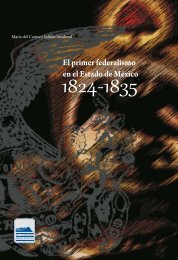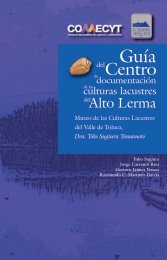Create successful ePaper yourself
Turn your PDF publications into a flip-book with our unique Google optimized e-Paper software.
KORPUS <strong>21</strong>, VOL. 4, NÚM. <strong>10</strong>, 2024, 67-78<br />
seen, and these factors, and the rebellion that<br />
flowed in part from them, made La Purísima’s<br />
life story exceptional.<br />
But conflict within convents, I soon learned,<br />
was not uncommon at all. Since I had not originally<br />
intended to write a book about a convent,<br />
I had not mastered the secondary literature<br />
before I went into the archive, and in my ignorance<br />
the rebellions in San Miguel struck me as<br />
strange and fascinating. When I began reading<br />
widely on convents, at first I was disappointed<br />
that the rebelliousness and factionalism so<br />
clearly on display at La Purísima was actually a<br />
fairly ordinary part of convent life, as Asunción<br />
Lavrin for Puebla and Luis Martins for Lima and<br />
others had shown (Lavrin, 1965; Martín, 1983). 11 I<br />
quickly figured out, though, that this commonality<br />
was a good thing, because it allowed me to<br />
theorize how convents functioned and why conflict<br />
should be a generalized feature of convent<br />
life, advancing our understanding of convents<br />
(and perhaps more broadly, other institutions<br />
where some version of segregation by sex or<br />
enclosure was the rule, like boarding schools or<br />
fraternity or sorority houses). I would certainly<br />
be able to go beyond the conclusion of the men<br />
who opined about the troubles at La Purísima,<br />
who simply saw pettiness and disagreement as<br />
a natural thing among houses of women.<br />
If the rebellions were not unique in themselves,<br />
however, the surviving material on them<br />
was unusually rich in detail, featuring not only<br />
dozens of letters from the abbesses, the bishop<br />
and the vicar, but also three lengthy reports<br />
from the officials the bishop sent to the convent<br />
to investigate, as well as handwritten testimonials<br />
and correspondence from the nuns themselves,<br />
both the “obedient” ones and the rebellious<br />
ones. (Perhaps the fact that the material<br />
was not only misfiled, but also contained in a<br />
file folder that was innocuously labeled “Gobi-<br />
11 See also: Mystic of Tunja: The Writings of Madre Castillo,<br />
1671-1742 (McKnight, 1997); Mexican Karismata: the<br />
Baroque Vocation of Francisca de los Angeles, 1674-1744<br />
(Gunnarsdóttir,2004); Los conventos femeninos y el mundo<br />
urban de la Puebla de los Ángeles del siglo XVIII (Loreto,<br />
2000), La vida común en los conventos de monjas de la<br />
ciudad de Puebla (Salazar, 1990); “Controversías sobre la<br />
‘vida común’ ante la reforma monacal femenina en México,<br />
(Sarabia, 1995); Virgins of Venice: Enclosed Lives and Broken<br />
vows in the Renaissance Convent (Laven, 2002);, Sisters<br />
in Arms: Catholic Nuns through Two Millenia, (McNamara,<br />
1996); A Convent Tale: A Century of Sisterhood in Spanish<br />
Milan, (Baernstein, 2002).<br />
erno del convento,” was part of the reason for<br />
the survival of this much detail. If the label had<br />
signaled the scandalous nature of the material<br />
within, someone down the centuries might have<br />
caused it to disappear.) Thus, based solely on<br />
the materials directly concerning the rebellion, I<br />
could add to the literature on convent function<br />
and dysfunction.<br />
In addition, however, I also had a wealth of<br />
information on the convent’s finances, demography,<br />
and internal processes over time, material<br />
I could pair with the documentation on the<br />
rebellion to enrich my understanding of the role<br />
it had (or didn’t have) in shaping the particular<br />
life history of this convent. Between the richness<br />
of the material on the rebellion directly and the<br />
completeness of the record of other aspects of<br />
the convent’s history, I stood a good chance of<br />
producing both a great story and an illustrative<br />
story, the core of a good biography.<br />
Prosopography of the nuns<br />
The grand narrative of the convent’s life story<br />
after the decade of rebellion in the 1760s was<br />
one of struggle, both financial and institutional.<br />
The convent continued to fall more and more<br />
into debt until well after Mexican independence,<br />
and it failed even to come close to its capacity<br />
of 72 nuns. The fairly obvious conclusion was<br />
that the rebellions had in some way fatally damaged<br />
the convent’s reputation so that young<br />
women whose families had fought to establish<br />
the convent in San Miguel no longer wanted to<br />
enter. But how many years after the end of a<br />
rebellion is it reasonable to expect that potential<br />
entrants would still reject the convent? The<br />
efforts by both bishops and abbesses in the<br />
1770s and 1780s to mollify the rebellious nuns<br />
were largely successful, and conflict within the<br />
convent diminished from a boil to a low simmer,<br />
no different from most convents. But La<br />
Purísima, compared to the other convents in the<br />
bishopric, continued to struggle to balance its<br />
books and attract new postulants. Were there<br />
other factors —either loosely connected to the<br />
rebellion or independent of it— that made this a<br />
“troubled” convent? The materials on the rebellion<br />
alone would not answer this question.<br />
Among the records of this convent, as was<br />
true of most convents, were those concerning<br />
71


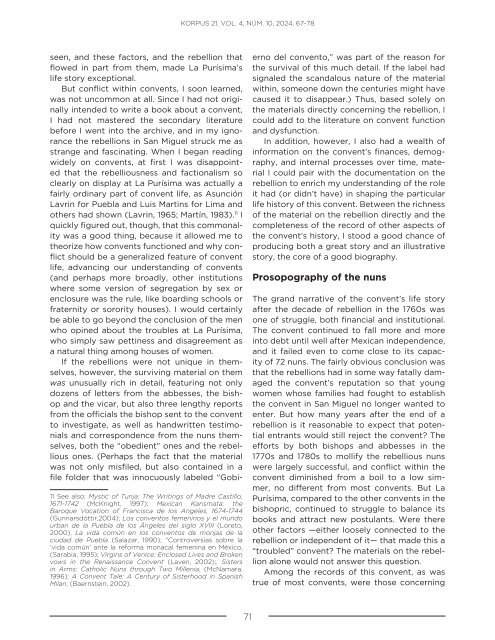
![bicentenario_1[V2]](https://img.yumpu.com/68677971/1/167x260/bicentenario-1v2.jpg?quality=85)
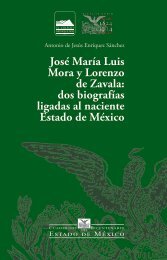
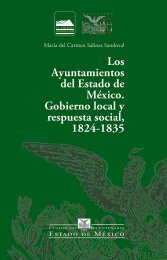

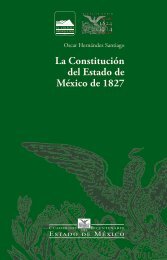
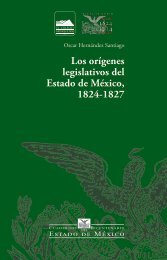
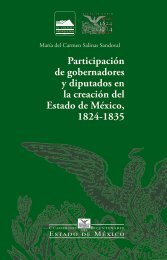
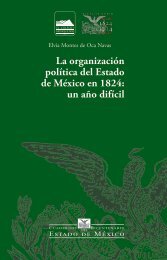
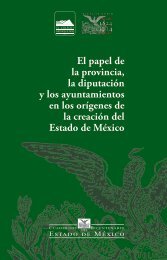
![El_primer_federalismoEM[final]_compressed (2)](https://img.yumpu.com/68483279/1/178x260/el-primer-federalismoemfinal-compressed-2.jpg?quality=85)
